Archilife Delegation for SB2002 International Conference(2)Date: 2002-09-28
Section: SB Series of International Conferences |  接著,則由Prof. Kazuo Iwamura、Prof. William Lim及Prof. Wan Ki Chow 進行演講。隨後由本會研究案主持人闡述各該領域的研究內涵,郭肇立教授演講「Bunun Dwelling : A Study on the Tectonic Culture of the Aborigines in Taiwan」、喻肇青教授演講「The Application of a Full-Scale Experimental Model in the Climate Chamber in Taiwan」、江哲銘教授演講「New Climate-Oriented Designing and Controlling Stratery for Sustainable Building in Subtropical Region」、蘇慶華教授演講「Integration of a Symbiotic Living Construction - A High Efficient Recycling System」。 接著,則由Prof. Kazuo Iwamura、Prof. William Lim及Prof. Wan Ki Chow 進行演講。隨後由本會研究案主持人闡述各該領域的研究內涵,郭肇立教授演講「Bunun Dwelling : A Study on the Tectonic Culture of the Aborigines in Taiwan」、喻肇青教授演講「The Application of a Full-Scale Experimental Model in the Climate Chamber in Taiwan」、江哲銘教授演講「New Climate-Oriented Designing and Controlling Stratery for Sustainable Building in Subtropical Region」、蘇慶華教授演講「Integration of a Symbiotic Living Construction - A High Efficient Recycling System」。
Then, Professor Kazuo Iwamura, Professor William Lim, and Professor Wan Ki Chow gave their speeches. After their speeches, principal investigators of ARF research projects presented the contents of their projects. Professor Kuo Chao-lee presented "Bunun Dwelling: A Study on the Tectonic Culture of the Aborigines in Taiwan", Professor Yu Chao-ching presented "The Application of a Full-scale Experimental Model in the Climate Chamber in Taiwan", Professor Chiang Che-ming presented "New Climate-Oriented Designing and Controlling Strategy for Sustainable Building in Subtropical Region", and Professor Su Ching-hua presented "Integration of a Symbiotic Living Construction: A High Efficient Recycling System".
 最後,黃晉英秘書長也以主席的身分總結本會針對永續建築議題所提出之解決方案 : " GB + Symbiosis = SB " 。這場祐生在國際場合進行演說的處女作,現場反應熱烈, 座無虛席,充分顯示與會者對亞熱帶永續建築議題的興趣。 最後,黃晉英秘書長也以主席的身分總結本會針對永續建築議題所提出之解決方案 : " GB + Symbiosis = SB " 。這場祐生在國際場合進行演說的處女作,現場反應熱烈, 座無虛席,充分顯示與會者對亞熱帶永續建築議題的興趣。
Lastly, Secretary General Huang Chin-ying concluded the keynote speech as the chairperson of the session by introducing our solution for sustainable building: " GB + Symbiosis = SB " . This premier showing of ARF attracted heated feedback, and all seats were occupied. This suggests that attendees were interested in issues concerning sustainable buildings in the subtropics.
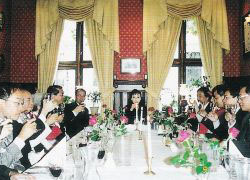 為答謝演講者之辛勞與付出,黃晉英秘書長細心選定在奧斯陸市具百年歷史的餐廳舉行慶功宴,讓大家聚在一起分享、交換彼此的心得與感想。而遠在地球另一端的林俊興董事長也在此刻來電,除了表達關心,也對所有演講者的精湛表現表達他的祝賀以及慰勞之意,在一陣舉杯慶祝的歡笑聲中,也為此次的演說活動畫下完美的句點。 為答謝演講者之辛勞與付出,黃晉英秘書長細心選定在奧斯陸市具百年歷史的餐廳舉行慶功宴,讓大家聚在一起分享、交換彼此的心得與感想。而遠在地球另一端的林俊興董事長也在此刻來電,除了表達關心,也對所有演講者的精湛表現表達他的祝賀以及慰勞之意,在一陣舉杯慶祝的歡笑聲中,也為此次的演說活動畫下完美的句點。
Secretary General Huang Chin-ying carefully chose a 100-year-old restaurant in Oslo to hold the celebration party to show her gratitude for the toil and devotion of speakers and to let delegates share their experience and opinions. President Lin Chun-shin also called from the other side of the world to express his concern and appreciation for the wonderful performance and efforts of all speakers. The keynote speech finally ended smoothly in the joyous celebration party.
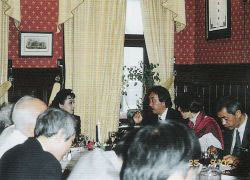 下午登場的閉幕式,由大會總結數天來的研討成果,宣布此次大會七項重要結論並頒發獎項,本屆永續建築國際會議在如雷的掌聲中圓滿落幕,大家相約2005年東京再見,也期盼屆時在永續議題上會出現更新的進展與突破。 下午登場的閉幕式,由大會總結數天來的研討成果,宣布此次大會七項重要結論並頒發獎項,本屆永續建築國際會議在如雷的掌聲中圓滿落幕,大家相約2005年東京再見,也期盼屆時在永續議題上會出現更新的進展與突破。
At the closing ceremony held in the afternoon, the organizer concluded the results of the SB2002 Oslo, announced seven major conclusions, and presented prizes to the winners. The SB2002 Oslo ended smoothly with the applause of the attendees, and everyone wished to see one another again and that newer progress and breakthroughs on sustainability would be presented at SB2005 Tokyo.
 晚間,黃晉英秘書長特別設宴款待年輕的考察團員。晚餐的地點選在燈光美、氣氛佳的挪威式高級迪斯可與鋼琴酒吧。在卸下專題演講的重責大任後,黃晉英秘書長終於拋開嚴肅的備戰精神,露出久違的開朗、親切笑容,席間她分別和團員們話家常,團員們也迫不及待地發表此行的體驗與感受,笑聲此起彼落,氣氛好不熱絡。在連日緊湊的研討會後,團員們總算放下心中的大石頭,準備迎接大會安排的觀摩見識之旅一探索斯堪地那維亞(Explore Scandinavia) 晚間,黃晉英秘書長特別設宴款待年輕的考察團員。晚餐的地點選在燈光美、氣氛佳的挪威式高級迪斯可與鋼琴酒吧。在卸下專題演講的重責大任後,黃晉英秘書長終於拋開嚴肅的備戰精神,露出久違的開朗、親切笑容,席間她分別和團員們話家常,團員們也迫不及待地發表此行的體驗與感受,笑聲此起彼落,氣氛好不熱絡。在連日緊湊的研討會後,團員們總算放下心中的大石頭,準備迎接大會安排的觀摩見識之旅一探索斯堪地那維亞(Explore Scandinavia)
In the evening, Secretary General Huang Chin-ying treated the young delegates with a feast at a classy Norwegian disco and piano bar with beautiful lighting and an excellent atmosphere. After accomplishing the keynote speech mission, Secretary General Huang Chin-ying finally put away her tension and wore her cheerful and sincere smile that has not been seen for quite a while. She chatted with those young delegates who shared with her their experience and feelings about the trip without hesitation. There was laughter everywhere, and the atmosphere was warm. After the tightly scheduled seminar, delegates finally put away their mental burden and were ready for the Explore Scandinavia, a trip of exploration.
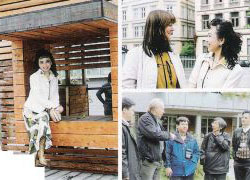 9月26日早上,團員們首先參加大會為來自世界各地參訪人員貼心安排的行前說明會,因為人數眾多,大會還特別安排專車搭載祐生的團員,並隨車安插大會主要籌辦人員Trine為導遊帶領團員們參觀接下來的行程。首先,第一個案例是位於奧斯陸市的Klosterenga Ecology dwellings,這是由一群以共同節能為訴求的有心家庭進駐的小型社區。建築中庭有一個小型花園,中間並設有兒童遊戲區可供嬉戲,花園中藏有無限生機,有白色圓形淨水設備、水生植物區與結實累累的各式植物。庭院中的一切設計皆與節能、能源再使用的概念相連。建物內部的設計更發揮節能到極致,採自然通風、隔熱設計,還有冬天暖氣的來源是地板下輸熱水的水管,以達省能效果。而其中一戶懷抱著小娃的女主人更是熱心地為大家解說自家屋內的各項陳設。從這樣的參訪中,也讓人更進一步地了解到挪威人的生活與一塵不染的生活空間。 9月26日早上,團員們首先參加大會為來自世界各地參訪人員貼心安排的行前說明會,因為人數眾多,大會還特別安排專車搭載祐生的團員,並隨車安插大會主要籌辦人員Trine為導遊帶領團員們參觀接下來的行程。首先,第一個案例是位於奧斯陸市的Klosterenga Ecology dwellings,這是由一群以共同節能為訴求的有心家庭進駐的小型社區。建築中庭有一個小型花園,中間並設有兒童遊戲區可供嬉戲,花園中藏有無限生機,有白色圓形淨水設備、水生植物區與結實累累的各式植物。庭院中的一切設計皆與節能、能源再使用的概念相連。建物內部的設計更發揮節能到極致,採自然通風、隔熱設計,還有冬天暖氣的來源是地板下輸熱水的水管,以達省能效果。而其中一戶懷抱著小娃的女主人更是熱心地為大家解說自家屋內的各項陳設。從這樣的參訪中,也讓人更進一步地了解到挪威人的生活與一塵不染的生活空間。
In the morning on September 26, delegates first participated in the pre-trip meeting thoughtfully arranged by the organizer for attendees from different parts of the world. As there were too many people, the organizer arranged a special bus to take ARF delegates. Trine, one of the key planners of SB2002 Oslo, was also assigned as our guide for the trip. First, it was the Klosterenga, a case of ecological dwellings located in Oslo City. It was a small community inhabited by families devoted to saving energy together. In the community, there was a small garden in the center court, and there was a children playground for recreation. There were countless lives in the garden, the white circular water purification facility, aqua plant area and various fruiting plants. Everything in the court was related with energy saving and reuse. The interior design of the buildings was a perfect illustration of saving energy. It included natural ventilation and heat insulation design. Also, the hot water pipes under the floor were the source of heat in winter to save energy. The owner of a unit holding her baby in her hands showed us the layout of her home enthusiastically. From this visit, we could understand better the Norwegian life and their clean living space.
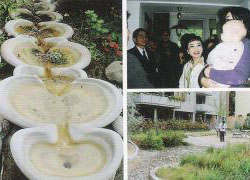 接著考察團一行驅車前往Pilestredet Park參訪更新再造的案例,設計者將廢棄不用的舊穀倉經由分層改建為學生宿舍,現場可看到高聳的穀倉變成塗有亮麗色彩外觀的宿舍,為舊建築注入了新的生命。宿舍周遭的環境清幽,旁又有小河蜿蜒,真是讓人對居住此處的學子們心生豔羨'也讓團員們對即將啟動的「共生圈一號」寄予無限的厚望。 接著考察團一行驅車前往Pilestredet Park參訪更新再造的案例,設計者將廢棄不用的舊穀倉經由分層改建為學生宿舍,現場可看到高聳的穀倉變成塗有亮麗色彩外觀的宿舍,為舊建築注入了新的生命。宿舍周遭的環境清幽,旁又有小河蜿蜒,真是讓人對居住此處的學子們心生豔羨'也讓團員們對即將啟動的「共生圈一號」寄予無限的厚望。
Then, we visited a renewal case in Pilestredet Park. The designer turned an abandoned barn into a multi-storey dormitory. In the scene, we saw the towering barn has turned into a dormitory with a colorful appearance, injecting a new life to an abandoned building. The near neighborhood was quiet, and there was a river running across. The whole environment made one envy of the students living there and inspired ARF delegates'great expectation on Symbiosphere 1 Center.
 中午時刻,考察團一行在前往Fredrikstad途中的Balaklava鎮用餐。在車行的途中,黃晉英秘書長除了感謝大家連日來的辛勞,也希望團員們趁記憶猶新時,寫下這次參與國際研討會的心得與待改進之處,並儘量描繪曾交談過國際友人的形貌與對話的內容,讓此行有更完整與詳盡的收穫可供日後索引。用餐前,大會特別安排一位充滿書卷氣息的長者為大家解說這座古老城鎮的歷史與街道,讓人動容不已。在前往下一個目的地的空檔,大家紛紛把握時間,不論是港口、砲台、城鬥、木屋、小徑或花園等都留下大家美麗的倩影,盡情享受這短暫的浮生半日閒。 中午時刻,考察團一行在前往Fredrikstad途中的Balaklava鎮用餐。在車行的途中,黃晉英秘書長除了感謝大家連日來的辛勞,也希望團員們趁記憶猶新時,寫下這次參與國際研討會的心得與待改進之處,並儘量描繪曾交談過國際友人的形貌與對話的內容,讓此行有更完整與詳盡的收穫可供日後索引。用餐前,大會特別安排一位充滿書卷氣息的長者為大家解說這座古老城鎮的歷史與街道,讓人動容不已。在前往下一個目的地的空檔,大家紛紛把握時間,不論是港口、砲台、城鬥、木屋、小徑或花園等都留下大家美麗的倩影,盡情享受這短暫的浮生半日閒。
At noon, the delegation had lunch in Balaklava, a town on transit to Fredrikstad. In addition to expressing her gratitude for the toil of delegates, Secretary General Huang Chin-ying hoped that they could write down what they have learned from the trip and what improvements should made when they could still remember everything. She also asked them to depict, as much as possible, the facial features and conversation of international friends they have talked to in order to provide more complete and detailed information for future retrieval. Before the lunch, it was really touching that the organizer arranged a scholarly senior to show delegates the history and road network of this ancient town. Before heading for the next destination, delegates grasped the time to visit the harbor, forts, city gates, log cabins, paths and parks in the vicinity in order to freely enjoy this leisure moment in the busy life.
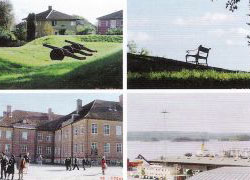 在經過大約半個多小時的車程,考察團一行終於抵達位於Fredrikstad的Kvernhuset Junior High School進行參觀。這是一所以永續建築理念所興建的學校,由當地社區人士集體經營與構思,原本預計於2002年六月左右完工啟用,但在考察團抵達的當時卻尚在興建當中,也讓我們有機會一睹其造作過程。學校牆壁的外緣是選用當地產的碎石裝入金屬網搭建,令人耳目一新也感到震撼。設計者用心地利用與設計各式各樣的場景,學校也派出專人為大家解說,從建材、採光、太陽能板、地貌的保留、管線配置、廁所到污水處理池等裝置,在這所學校裡處處可見設計者的巧思與細膩,讓人印象深刻。 在經過大約半個多小時的車程,考察團一行終於抵達位於Fredrikstad的Kvernhuset Junior High School進行參觀。這是一所以永續建築理念所興建的學校,由當地社區人士集體經營與構思,原本預計於2002年六月左右完工啟用,但在考察團抵達的當時卻尚在興建當中,也讓我們有機會一睹其造作過程。學校牆壁的外緣是選用當地產的碎石裝入金屬網搭建,令人耳目一新也感到震撼。設計者用心地利用與設計各式各樣的場景,學校也派出專人為大家解說,從建材、採光、太陽能板、地貌的保留、管線配置、廁所到污水處理池等裝置,在這所學校裡處處可見設計者的巧思與細膩,讓人印象深刻。
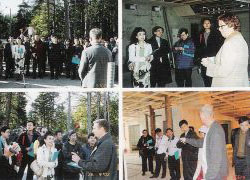 After about half an hour's ride, we finally arrived in Fredrikstad and began visiting the Kvernhuset Junior High School. It was a school built in the sustainable building concept and operated collectively by locals. As the projected date of completion was around June 2002, it was still under construction when we visited. This also gave us a great opportunity to see the construction process of a sustainable building. The edge of the school's external wall was made with local stones and metal webbing. It was refreshing and sensational. Designers carefully designed the building based on local scenes. The school also assigned staff to explain to us some details of the school, including the construction materials, lighting policy, solar boards, terrain conservation, pipeline layout, toilet and sewage treatment. The careful and crafty design of the architect was seen everywhere in the school, and it was impressive. After about half an hour's ride, we finally arrived in Fredrikstad and began visiting the Kvernhuset Junior High School. It was a school built in the sustainable building concept and operated collectively by locals. As the projected date of completion was around June 2002, it was still under construction when we visited. This also gave us a great opportunity to see the construction process of a sustainable building. The edge of the school's external wall was made with local stones and metal webbing. It was refreshing and sensational. Designers carefully designed the building based on local scenes. The school also assigned staff to explain to us some details of the school, including the construction materials, lighting policy, solar boards, terrain conservation, pipeline layout, toilet and sewage treatment. The careful and crafty design of the architect was seen everywhere in the school, and it was impressive.
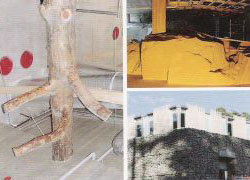 結束上述行程後,巴士沿著高速公路穿越挪威與瑞典的國界,我們正式告別停留了六天之久的挪威,進入另一個國度,前往位於瑞典的哥德堡(Gothenburg)。 結束上述行程後,巴士沿著高速公路穿越挪威與瑞典的國界,我們正式告別停留了六天之久的挪威,進入另一個國度,前往位於瑞典的哥德堡(Gothenburg)。
After these visits, the bus headed toward the Norwegian border with Sweden on the highway, marking our official farewell to Norway, a place where we have stayed for six days. The next stop was Gothenburg, Sweden.
 入夜後,考察團一行順利抵達位於哥德堡的生態中心(EcoCentrum),參觀該中心所展示的各種節能設備,解說員並詳盡地說明太陽能板、分類機制與燃料電池等構造與相關課題,雖然舟車勞頓,但考察團員們仍舊打起精神,馬不停蹄地蒐集資料,企望為即將開張的「共生圈一號」提供更多的助益。就在分批享用晚餐後,大家拖著繁重的行李搭車到下榻的Quality Hotel休息。 入夜後,考察團一行順利抵達位於哥德堡的生態中心(EcoCentrum),參觀該中心所展示的各種節能設備,解說員並詳盡地說明太陽能板、分類機制與燃料電池等構造與相關課題,雖然舟車勞頓,但考察團員們仍舊打起精神,馬不停蹄地蒐集資料,企望為即將開張的「共生圈一號」提供更多的助益。就在分批享用晚餐後,大家拖著繁重的行李搭車到下榻的Quality Hotel休息。
When the night fell, we arrived at the Ekocentrum in Gothenburg to visit various energy saving facilities displayed there. The escort explained to us in detail the structure and related issues of different kinds of solar boards, their classifications, and fuel batteries. Though we had traveled a long way, we kept our spirits up to collect information, hoping that it could be useful for the upcoming Symbiosphere 1 Center. After having dinner in groups, we dragged the heavy luggage and took the bus to the Quality Hotel.
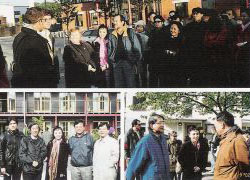 9月27日一早,團員們不畏凜冽的寒風,紛紛到Quality Hotel旁的碼頭飽覽風光。經過解說員的說明後,大家才知道這所旅館是由船塢改建而成,其中還加添後現代手法的室內設計。在這裡的天氣感覺上比起挪威還冷得多,連港口旁的木製地板上都覆有薄冰,也讓我們這群來自熱帶國度的過客們不由自主地搓起手來取暖。 9月27日一早,團員們不畏凜冽的寒風,紛紛到Quality Hotel旁的碼頭飽覽風光。經過解說員的說明後,大家才知道這所旅館是由船塢改建而成,其中還加添後現代手法的室內設計。在這裡的天氣感覺上比起挪威還冷得多,連港口旁的木製地板上都覆有薄冰,也讓我們這群來自熱帶國度的過客們不由自主地搓起手來取暖。
In early morning on September 27, showing no fear of the chilly wind, we went sightseeing at the pier next to the Quality Hotel. After the explanation of the escort, we finally found out that the hotel was built from a dock with some postmodernist interior design. We felt it was colder than in Norway, and there was thin frost on the wooden floor near the harbor. From a subtropical country, we just could not help rubbing our hands to get warmer.
 在短暫的巡覽後,考察團一行搭車來到哥德堡的新市區Norra Alvstranden進行參訪,隨後則轉往Gardsten接受由瑞典當地知名企業Skanska所安排的參觀行程。由於天氣寒冷,接待單位特別為參觀團員準備熱騰騰的咖啡怯寒。Gardsten主要是由Skanska公司出資所進行之老舊建築更新轉型為生態建築的案例,也是該企業回饋社會的具體作為。團員們按導覽一一參觀其內的設施,建築物旁設有玻璃溫室以保留熱,溫室中也種植許多作物,有不同品種的番茄、草莓與香草,而溫室連接到室內就有一台廚餘處理機,其內的食物殘渣,最後將做成堆肥提供溫室中的植物使用。 在短暫的巡覽後,考察團一行搭車來到哥德堡的新市區Norra Alvstranden進行參訪,隨後則轉往Gardsten接受由瑞典當地知名企業Skanska所安排的參觀行程。由於天氣寒冷,接待單位特別為參觀團員準備熱騰騰的咖啡怯寒。Gardsten主要是由Skanska公司出資所進行之老舊建築更新轉型為生態建築的案例,也是該企業回饋社會的具體作為。團員們按導覽一一參觀其內的設施,建築物旁設有玻璃溫室以保留熱,溫室中也種植許多作物,有不同品種的番茄、草莓與香草,而溫室連接到室內就有一台廚餘處理機,其內的食物殘渣,最後將做成堆肥提供溫室中的植物使用。
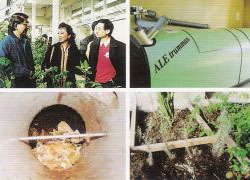 After a short tour, we took bus to visit Norra Alvstranden in Gothenburg. Later on, we turned to Gardsten for the tour arranged by the famous Swedish business, Skanska. As it was freezing out there, they prepared hot coffee for us. Gardsten was a green building renewed from an abandoned building funded by Skanska as feedback for society. With the tour map, we explored the facilities in Gardsten. There was a glass greenhouse next to the building to preserve heat. There were different plants grown, such as tomatoes, strawberries, and vanilla. There was a kitchen waste processing linking the greenhouse and indoor. Kitchen waste was turned into compost for use by plants inside the greenhouse. After a short tour, we took bus to visit Norra Alvstranden in Gothenburg. Later on, we turned to Gardsten for the tour arranged by the famous Swedish business, Skanska. As it was freezing out there, they prepared hot coffee for us. Gardsten was a green building renewed from an abandoned building funded by Skanska as feedback for society. With the tour map, we explored the facilities in Gardsten. There was a glass greenhouse next to the building to preserve heat. There were different plants grown, such as tomatoes, strawberries, and vanilla. There was a kitchen waste processing linking the greenhouse and indoor. Kitchen waste was turned into compost for use by plants inside the greenhouse.
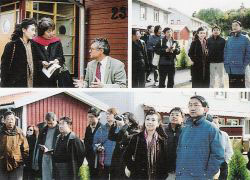 中午,團員們在生態屋旁的餐廳內享用由Skanska公司招待之午餐後,繼續風塵僕僕走訪位於Lindas的無耗能住宅(O-energy houses),實地考察當地生態建築運作的現況。接著考察團一行驅車前往車程三個多小時遠的Malmo,參觀當地著名的BoOl案例。本區原為工業區,經過都市再更新計畫的推動,使其重新披上嶄新的外衣,有了新的風貌。團員們徒步穿梭於街道中,在解說者的導引下,一一觀摩體驗當地住民如何力行低耗能,甚至是不耗能的生活,其中的曝氣水池、水生植物區與美麗的海岸等都讓大家留下了深刻的印象。 At noon, after enjoying lunch provided by Skanska in the restaurant of Gardsten, we continued our visit to the 0-energy houses in Lindas to observe the present operations of local eco-buildings. Then, we traveled to Malmo, about 3-hour ride, to visit the famous BoO1 case there. Malmo was an industrial area, and it put on a brand new coat after the urban renewal. While shuffling through the city, under the guidance of the escort, we observed how local inhabitants practiced the low-energy and even 0-energy life. The aeration pond, aqua plant area and beautiful shore there impressed us a lot. 中午,團員們在生態屋旁的餐廳內享用由Skanska公司招待之午餐後,繼續風塵僕僕走訪位於Lindas的無耗能住宅(O-energy houses),實地考察當地生態建築運作的現況。接著考察團一行驅車前往車程三個多小時遠的Malmo,參觀當地著名的BoOl案例。本區原為工業區,經過都市再更新計畫的推動,使其重新披上嶄新的外衣,有了新的風貌。團員們徒步穿梭於街道中,在解說者的導引下,一一觀摩體驗當地住民如何力行低耗能,甚至是不耗能的生活,其中的曝氣水池、水生植物區與美麗的海岸等都讓大家留下了深刻的印象。 At noon, after enjoying lunch provided by Skanska in the restaurant of Gardsten, we continued our visit to the 0-energy houses in Lindas to observe the present operations of local eco-buildings. Then, we traveled to Malmo, about 3-hour ride, to visit the famous BoO1 case there. Malmo was an industrial area, and it put on a brand new coat after the urban renewal. While shuffling through the city, under the guidance of the escort, we observed how local inhabitants practiced the low-energy and even 0-energy life. The aeration pond, aqua plant area and beautiful shore there impressed us a lot.
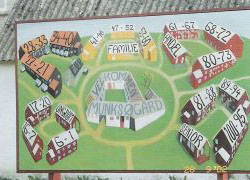 晚上,團員們在Malmo用過道地的瑞典晚餐後,隨即轉往本次參訪行程的最後一站:丹麥首都哥本哈根。在此次參觀行程中,來自大陸的參加人員也時時隨侍在側,讓團員們有機會領教到來自對岸的威脅與虎視耽耽,所幸團長等人因應得宜,才使祐生此行圓滿達成任務。 晚上,團員們在Malmo用過道地的瑞典晚餐後,隨即轉往本次參訪行程的最後一站:丹麥首都哥本哈根。在此次參觀行程中,來自大陸的參加人員也時時隨侍在側,讓團員們有機會領教到來自對岸的威脅與虎視耽耽,所幸團長等人因應得宜,才使祐生此行圓滿達成任務。
In the evening, we had an authentic Swedish dinner in Malmo. Then, we headed to the last stop of our trip: Copenhagen, capital of Denmark. On our trip, participants from Mainland China were walking side by side all the way, and we just felt the threats and the scrutiny from the opposite side of the Taiwan Straits. Fortunately, we could accomplish the mission smoothly with the skilful maneuvering of Secretary General Huang Chin-ying and others.
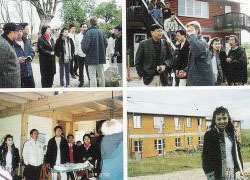 9月28日一早,考察團員按原訂計畫前往參觀幼稚園kindergarten Stenurten及位於Mlinkesogard的100 ecologicail houses,因為司機對路程不熟悉,耽擱了許多寶貴的時間,為了不延誤考察團回國的行程,團長於是當機立斷取消Kindergarten Stenurten行程,直接前往Munkesogard參觀lOO ecological houses。在這座生態村內規劃有不同的區塊與建築,分別居住著不同年齡層的住民,他們過著類似人民公社般的共同生活。比較難得的是這座村落是由一群有共同理念的人民自發性地營居,設有自己循環的堆肥與畜牧系統,並且共同分享所有的勞務,他們的運作經驗有不少更值得做為未來推展共生生活之借鏡。 9月28日一早,考察團員按原訂計畫前往參觀幼稚園kindergarten Stenurten及位於Mlinkesogard的100 ecologicail houses,因為司機對路程不熟悉,耽擱了許多寶貴的時間,為了不延誤考察團回國的行程,團長於是當機立斷取消Kindergarten Stenurten行程,直接前往Munkesogard參觀lOO ecological houses。在這座生態村內規劃有不同的區塊與建築,分別居住著不同年齡層的住民,他們過著類似人民公社般的共同生活。比較難得的是這座村落是由一群有共同理念的人民自發性地營居,設有自己循環的堆肥與畜牧系統,並且共同分享所有的勞務,他們的運作經驗有不少更值得做為未來推展共生生活之借鏡。
In the early morning on September 28, we visited Kindergarten Stenurten and 100 ecological houses in Mlinkesogard as planned. We wasted some precious time because the driver was unfamiliar with the way to get there. Secretary General Huang Chin-ying immediately decided to skip the Kindergarten Stenurten and directly visit the 100 ecological houses in Munkesogard to ensure that the homecoming schedule was not delayed. In this ecological community, there were different zones and buildings for inhabitants of different ages living in a lifestyle like that of a commune. It was rather precious that the community was voluntarily run by a group of people sharing the same way of thinking. They had their own compost and animal rearing systems and shared all labor services. Their way of operations is valuable for promoting the commune life in the future.
在用過午餐後,考察團員再也難掩滿腹的思鄉愁緒,個個歸心似箭,整裝準備踏上歸途。因為班機安排分批以策安全的緣故,年輕的考察團員還有時間進行半日之哥本哈根市區巡覽,而團長及主持人們則先行趕往機場。在黃晉英秘書長的殷切叮嚀與重點任務提示下,考察團員就此分道而行,活力十足的年輕團員們興緻勃勃地出發,陸續參觀丹麥港、皇宮、小美人魚雕像、噴水池與各個廣場等,並看到全世界第一座遊樂場。在興高采烈地與安徒生雕像合影紀念後,最後也依依不捨地踏上回家的旅途。
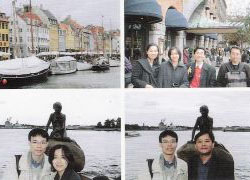 After lunch, we could not hide our nostalgic emotions anymore, and everyone just wanted to go home immediately. So we packed up everything to go home. For safety, we took different flights, and younger delegates still had time for a half-day tour of Copenhagen, while Secretary General Huang Chin-ying and principal investigators were headed to the airport first. After the thoughtful reminding and duty assignment of Secretary General Huang Chin-ying, we separated there. The energetic delegates visited the Denmark Harbor, Royal Palace, little mermaid statue, fountain and various squares, and even the world's first amusement park. After happily taking a picture with the statue of Hans Christian Andersen, they all started on the way home, though sad. After lunch, we could not hide our nostalgic emotions anymore, and everyone just wanted to go home immediately. So we packed up everything to go home. For safety, we took different flights, and younger delegates still had time for a half-day tour of Copenhagen, while Secretary General Huang Chin-ying and principal investigators were headed to the airport first. After the thoughtful reminding and duty assignment of Secretary General Huang Chin-ying, we separated there. The energetic delegates visited the Denmark Harbor, Royal Palace, little mermaid statue, fountain and various squares, and even the world's first amusement park. After happily taking a picture with the statue of Hans Christian Andersen, they all started on the way home, though sad.
 經過漫長的飛行與轉機,由團長為首的部分團員率先抵達桃園中正機場。林俊興董事長等人早已在機場等候多時,迎接考察團員的凱旋歸來。求好心切的林俊興董事長特別在機場闢室召開心得分享會議,除了再次表達感謝考察團員的辛勞與付出外,也順道了解考察團員帶回來的第一手資訊。 經過漫長的飛行與轉機,由團長為首的部分團員率先抵達桃園中正機場。林俊興董事長等人早已在機場等候多時,迎接考察團員的凱旋歸來。求好心切的林俊興董事長特別在機場闢室召開心得分享會議,除了再次表達感謝考察團員的辛勞與付出外,也順道了解考察團員帶回來的第一手資訊。
After the long flight and transit, Secretary General Huang Chin-ying and some delegates arrived at Taoyuan International Airport first. President Lin Chun-shin and others had been there waiting for the return of the delegation. A perfectionist, President Lin Chun-shin immediately held a sharing meeting with them at the airport. Besides expressing his gratitude for the efforts and devotions of delegates, President Lin Chun-shin wanted to get the first-hand information of the trip.
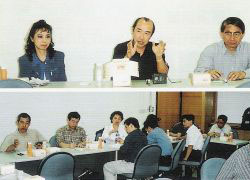 接著由團員們依序發表此行之收穫與感想。首先,江哲銘教授在稱許9月22日國際交流晚宴與9月25日專題演講成功之餘,也不忘提醒祐生必須為在東京舉辦之SB2005預做準備以及SB雜誌是一很好的交流平台;喻肇青副教授建議祐生可設置一個英文網站,並請求政府方面的配合;蘇慶華教授闡析此次國際研討會內容多偏向政策與評估指標,但仍欠缺如祐生一般有全方位整合的研究團隊;呂麗絲小姐除了轉達國外團隊對祐生之諸多褒獎外,也提出研討會的內涵隱含永續建築政策、技術與教育的挑戰。 接著由團員們依序發表此行之收穫與感想。首先,江哲銘教授在稱許9月22日國際交流晚宴與9月25日專題演講成功之餘,也不忘提醒祐生必須為在東京舉辦之SB2005預做準備以及SB雜誌是一很好的交流平台;喻肇青副教授建議祐生可設置一個英文網站,並請求政府方面的配合;蘇慶華教授闡析此次國際研討會內容多偏向政策與評估指標,但仍欠缺如祐生一般有全方位整合的研究團隊;呂麗絲小姐除了轉達國外團隊對祐生之諸多褒獎外,也提出研討會的內涵隱含永續建築政策、技術與教育的挑戰。
Then, delegates shared their gains and opinions from the trip one after another. First, beside approving the success of the international exchange banquet on September 22 and the keynote speech on September 25, Professor Chiang Che-ming reminded us to get prepared for the SB2005 Tokyo and that SB Magazine was an excellent exchange platform. Associate Professor Yu Chao-ching recommended that we set up an English website and requested government cooperation. Professor Su Ching-hua explained that policy and assessment indicator were the foci of the SB2002 Oslo, and it lacked an integrated research team like us. In addition to reporting the commendations from overseas teams, Miss Wu Lu Lee-shih pointed that the challenges in SB policies, technologies and education were hidden behind the seminar.
蘇慧貞教授則歸納西班牙團隊之所以得獎的緣由,為全國由上到下的動能與決心,從無到有的呈現,令評審者感動;李彥頤先生對國外建築師的看法提出他的觀察;林慶元教授說明主要回收材料多為磚、石與木,以及以木材做為環境調整用料等看法;陳泰安先生有感而發永續建築的系統多出自西方觀點,而提出永續的概念應發展區域特性,如溫熱、颱風與社會差異等;周伯丞先生指出祐生在建築循環的成果較具代表性,但差別在於國外已有深刻的體認並有意願將之付諸實行,即進駐到實驗建物中;蔡坤憲先生表示國外永續建築未考慮、熱、溫帶環境的差別,如公共衛生傳染病;林芳銘先生說明永續不僅須與政策教育結合,更須與商業結合,若加以推廣會更快。郭肇立教授闡述許多舊房子再利用的國外案例,建議可於SB2005提出本土的歷史建築再利用案例;李宏謨教授直陳永續建築案例中有生物多樣性、廚餘堆肥、乾式馬桶等概念,經營則應透過官方與非官方的共同努力;鍾基強教授指出永續建築已經有越來越多具工程背景的人投入,還有訂定永續建築評估指標等須再接再厲的目標;劉定衢先生分析現今祐生將不單面對來自中共內部的壓力,也包括中共參與的國際組織的壓力;李君如小姐提出永續建築中包含有網路連結、技術導向與案例研究等三大方向;鍾松晉先生說明永續的概念須推廣至台灣各地,而非侷限在室內的討論;王文安先生指出SB的案例有大幅擴增的現象,挪威案例擴展的效率也值得我們學習;高傳棋先生建議永續建築的推動可借力使力,藉由小規模的村落力量來推動,因為若由社會與社區出發,不易感覺到人的互動。接著,黃晉英秘書長除了再次肯定大家的努力,對於此行深入之知己知彼考察後,發現祐生的研究層級比參訪的國外案例都來得高,也感到相當慶幸,她亦不忘嘉獎祐生團員們的潛力,不管是國際禮儀或是以英語應對都展現出該有的水準。使祐生的國際化有了很好的開端,圓滿達成此行的任務。
Professor Su Huey-jen concluded the reasons why the Spanish team won the award: the whole country was courageous and determined and turned nothing into something. This was what impressed the jury. Mr. Li Yen-yi expressed his view on the opinions of foreign architects. Professor Lin Ching-yuan expressed that bricks, stones and wood were the main recyclable materials; and the idea of wood as an environmental adjustment material. Out of emotions, Mr. Chen Tai-an claimed that the SB system was introduced from the Western point of view, and recommended that sustainable development should correspond to regional characteristics, such as climate, typhoon pattern, and social differences. Mr. Chou Po-cheng pointed out that the ARF was quite outstanding in the area of building cycle, but it has been well recognized by foreign countries which would put it to practice, i.e. inhabiting in experimental buildings. Mr. Tsai Kun-hsien indicated that the differences between the temperate and tropical areas were not considered in SB proposed by foreign countries, such as public health and infectious diseases. Mr. Lin Fang-ming suggested that besides policies and education, sustainability should be combined with business, and it would be faster in the presence of promotion. Professor Kuo Chao-lee mentioned many examples concerning the reuse of old buildings overseas, and suggested that we may introduce a historical building reuse project at SB2005. Professor Lee Horng-mo directly pointed out that SB cases contained the biodiversity, kitchen waste compost and dry toilet concepts, and SB should be operated by the concerted effort of government and non-government organizations. Professor Chung Kee-chiang pointed out that more and more people with true engineering background were joining the SB area, and greater efforts were needed to establish the SB assessment indicators. Mr. Liu Ding-chyu maintained that the ARF not only needs to face the pressure from Communist China, but also the pressure from international organizations in which it participates in. Miss Li Chun-ju proposed that SB should include network connection, technical orientation, and case study. Mr. Chung Sung-chin suggested that the sustainability concept should be spread to all parts of Taiwan, instead of indoor discussions. Mr. Wang Wen-an pointed out that there was a large increase in SB cases, and we should learn from the expansion efficiency of Norway. Mr. Gao Chuan-chi suggested that we could promote SB with the power of others; i.e. we may start from small villages, because we may not feel human interactions from the society and community. Then, Secretary General Huang Chin-ying approved the hard work and devotion of everybody again and felt very happy to discover that the level of the ARF team was much higher than the team from other countries from this trip where we understood the strength of ourselves and others. She also praised the potentials of ARF members. In either international etiquette or English conversion, they did well and appropriately. This has brought a good start to ARF's internationalization. The mission of this trip was accomplished smoothly.
最後林俊興董事長也做出結論:「有關 GB 的基礎研究已趨向成熟,但因找不到出路,而開始走向 SB 這一路徑。然而,因為對 "S" 沒有概念,所以變成各說各話的局面,這其中的關鍵就在於缺少共生化。以往所有的人類文明就是不斷地向大自然需索,因而形成不斷擴張的結果。欲使擴張收斂,甚至趨向收縮,就必須採取共生化,否則無法成功。」
Lastly, President Lin Chun-shin drew the conclusions, "Though the basic GB research is mature, we started with SB because we haven't found the way out. However, as they have no idea about "S" , it turns out to be different people have a different story, and they do not realize that symbiosis is the key. Human civilizations used to take from nature, and incessant expansion was the consequence. If we want to control and even reduce expansion, we must practice symbiosis; otherwise, we'll fail."
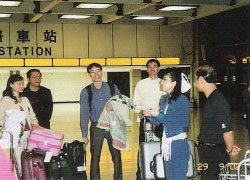 會議結束,林俊興董事長與黃晉英秘書長一一目送團員離去,接著繼續留在機場迎接其他團員的歸來。在他們的左顧右盼之下,團員們終於在接近子夜時分安抵國門,平安且順利地完成本次考察之旅。 會議結束,林俊興董事長與黃晉英秘書長一一目送團員離去,接著繼續留在機場迎接其他團員的歸來。在他們的左顧右盼之下,團員們終於在接近子夜時分安抵國門,平安且順利地完成本次考察之旅。
After the meeting was adjourned, President Lin Chun-shin and Secretary General Huang Chin-ying saw them off. Then, they continued to wait for other delegates at the airport. After a long expectation, other delegates returned to Taiwan at midnight, and the investigation trip ended smoothly.
此次祐生2002年永續建築國際會議考察團初試啼聲,成功地站上國際舞台,打開國際視野,並令國外學者留下深刻的印象,成果豐碩。但祐生並不以此為限,相反地,為了人類的永續,祐生將更加努力與奮鬥不懈驗證「共生圈一號」之可行性,讓世人共享祐生辛勤耕耘的果實。
Though the SB2002 Oslo was the first international event in which ARF participated, it successfully stood firm on the international stage, broadened its international view, and impressed foreign scholars. The results were fruitful. However, instead of being self-content, we shall continue to verify the feasibility of the Symbiosphere 1 Center with all our might and share our achievements with the world for the sustainability of mankind.
|
|